This weeks featured etsy shop is Honeyjane. It is filled with snuggly soft things for baby. Melissa, the shop owner is a super sweet lady that has offered to share an amazing tutorial with us. We will get to that later but first lets meet Melissa!
Look at this family! Are they not precious?!?!
Here is what Melissa has to say about herself: "I started sewing when I was 10, my Mom is an amazing seamstress and for my first sewing lesson we made an outfit together: pants, shirt, and a vest. I would do little sewing projects here and there growing up. When I had my own kids, I became interested in sewing more regularly and have loved making quilts, blankets, clothes, and gifts these past five years".
"I started an Etsy shop last year because I thought it would be fun and a place to share some of the projects I love to make. The blankets I sell are, in my opinion, the perfect size and weight for swaddling a baby".
"I swaddled my babies until they were four months old and these have always worked the best for me. Also, I love to use designer fabrics. Alexander Henry, Sandi Henderson, and Valori Wells are among my favorite designers".
"I live in Southern California, and stay at home with my two girls, ages 5 and almost 3. I love to read, cook (I recently started a recipe blog), and of course, sew. ;) I like to post some of my projects I'm working on here (among other things)".
Now that we know a little about Melissa, here is the wonderful tutorial that she has shared with us. It is perfect for using in children's rooms, nursery's or around the house. Everyone has baskets and with this great tutorial you can now create some stylish new liners for them!
Basket Liner Tutorial
Materials Needed:
• fabric-for my size liner 2 1/2 yards was enough for three basket liners
• fusible interfacing, medium weight• coordinating thread
• ruler
• cutting mat/rotary cutter
• pins
• sewing machine
• blind edge foot-if you have one
• seam gauge
• 1/2" ribbon-yardage depends on the size of your liner
1. Measure the basket you are lining. This tutorial will work best for medium to large sized baskets that are rectangular or square and do not taper in at the bottom. I am making a liner for a basket that is L11”xW11”xH9.5”.
Measurement A: Length
Measurement B: Width
Measurement C: Height
For the bottom piece, you will cut two of your fabric, and one of a medium-weight fusible interfacing. This will make the fabric nice and sturdy for the part of the liner that will fit in the bottom of the basket. Add ¼" to measurement A, and ¼" to measurement B, and this will be the dimensions you cut.
A + ¼” x B + ¼”
Mine measures 11 ¼ “ x 11 ¼”
For the sides of the liner – cut one long rectangle of fabric
Add 1 ¼” to the perimeter of the basket for width, and 6 3/8” to measurement C for heighth.
Length: A + A + B + B + 1 ¼”
Width: C + 6 3/8”
Mine measures 15 7/8” x 45 ¼” Here are my pieces all cut out and ready to be sewn:
2. Iron on the fusible interfacing to one of the bottom pieces. Make sure your iron is set to medium heat with no steam and that the glue bumps are facing the wrong side of the fabric.
3. Set aside bottom pieces for now.
4. On the short sides of the large rectangle piece, measure C + 2 1/8” from bottom and make a notch in the fabric a little more than ¼” in on both sides. Here is another picture to give you an idea of where to make the notch. Since my basket was 9 ½” high, I made a notch at 11 5/8”. (9 1/2" + 2 1/8" = 11 5/8)
5. Fold and press above the notch on both sides about 3/16". Fold and press over again another 3/16" to hide raw edge. Make sure you press the fold toward the wrong side of the fabric. It's kind of like a rolled hem, this will be where you tie the ribbon, so the ends need to be finished.
6. Topstitch along the narrow hem on both sides, make sure you backstitch at the beginning and end to keep the threads secured.
It should look like this:
7. You’re now going to make the ribbon enclosure. First, turn over 3/8” and press on the top length of the long rectangular piece. Use a seam gauge to be as accurate as possible.
8. Then, turn over 7/8” and press. The enclosure will be 7/8” when finished, and will hold a ½” ribbon.
9. Topstitch ribbon enclosure closed, make sure you backstitch at both ends. I like to use a blind stitch foot when doing this, it's really helpful and makes edge stitching a lot quicker and more accurate.
It should look like this where the ribbon will go:
10. Now we're going to work along the bottom edge of the large rectangle piece. We are going to be making four darts (one for each corner of the basket), so we need to pin or mark with a fabric marker where the darts will go. This will make it so your basket liner will be nice and fitted on the inside, since the liner has to be larger at the top to fit over the basket. And it's necessary so the large piece will fit just right when sewed to your bottom piece.
Your first measurement: Subtract 1" from your length first, then take half of that, and add 5/8". 1/2(A - 1") + 5/8" Mine is 5 5/8", since my length is 11" (11-1=10, 1/2 of 10 = 5, add 5/8" =5 5/8") Mark that measurement from the side, it doesn't matter if you start from the left or right, I started from the right.
From that pin, measure your width minus 1" (B - 1"). My width is 11", so I measured 10" from the 2nd pin. Mark with a pin or marker, and measure 1" from that pin. You have marked two darts so far. From the last pin, measure your length minus 1" (A - 1"), and then measure and mark 1" from that mark (the third dart). Then measure your width minus 1" (B-1") and measure 1" from that (the fourth dart). You now have marked all four darts. Your remaining measure of fabric should equal your starting measure of fabric (mine was 5 5/8"), give or take 1/4" and you should have a total of 8 pins, or 8 marks.
This picture is measuring from the first to the second dart:
11. The darts will be 8 1/8" long. So now you need to measure up from the middle of each 1" dart to 8 1/8" and mark with a pin or fabric marker.
12. To see where you're going to sew the dart, take a ruler and fold the dart so that the two pins or marks are on top of each other (on wrong side of fabric). Mark a line from the 8 1/8" mark down to one of your pins, don't remove the pins, you'll need them to line up the fabric correctly at the sewing machine. It should look like this:
13. Sew all four darts along the line you drew. Start from the top, backstitch, and go down to the bottom. I'm starting the seam at the top in this picture:
Each dart should look like this when finished:
14. Press each dart open, it will look like this on the wrong side of the fabric:
15. We are now ready to sew the sides together of the long rectangular piece so that it can be attached to your bottom piece. Mark 1 1/2" from the top, or ribbon enclosure, this is the point to where we'll sew the sides together. If we sewed all the way up, we wouldn't be able to put the ribbon in and tie it!
16. Sew the short sides of the long rectangular piece (right sides facing) together using a 5/8" seam. When you reach the finished seam (above the notch), you are going to gradually sew off the fabric, remember to backstitch!
It will look like this:
17. Snip threads. The top of your liner will now resemble this:
18. Finish your edge by serging it, using pinking shears, or a zigzag stitch. If you have a serger, it will look like this:
19. You are now ready to sew the top piece to the bottom piece. We will do this one side at a time. Layer your bottom pieces so the interfacing is in the middle and the right sides of the fabric are facing out.
20. The four darts are going to match up with the four corners of your bottom piece. We have to sew and finish the edges one side at a time. We're going to start with the side that has the seam between the two darts. You're going to pin this to the width side of your bottom piece. It's not going to match up exactly, but don't worry. Just pin it so the dart seams are equally far away from the edges of the bottom piece.
21. You're going to sew a 5/8" seam, remembering to backstitch at the beginning and end of the seam. Start at the first dart seam, not the edge of the fabric! And end at the second dart seam (not the edge!).
You have now sewed the first side, time to finish the edges of the fabric.
22. So that the fabric doesn't pull when sewing the next side, you're going to make a notch at either end of the fabric, but just on the top rectangular piece, not the bottom.
23. Now finish the edge.
24. Turn the fabric and pin your next side (the length). Again, your fabric will not reach all the way to the end, the seam of your dart should be about 5/8" away from the edge of the fabric. Sew from dart seam to dart seam, backstitching at the beginning and end. Finish raw edges. Do this twice more, until your large rectangular piece is sewed to the bottom piece on all four sides. Snip threads. Almost done!!
25. The last step is to pull your ribbon through the ribbon casing. Use a safety pin, and feed it all the way through. Burn the ends or set with fray check. Now it's ready to go into your basket!
Though this tutorial is a little complicated at first because of all the measurements, it only took me 1 hour to do 2 of these liners once I had all my measurements in place and the experience from making the first one.
I hope you enjoyed this wonderful tutorial shared with us by Melissa at Honeyjane! Now, go visit Melissa's blog and tell her how much you enjoyed her tutorial. Thanks Melissa!




















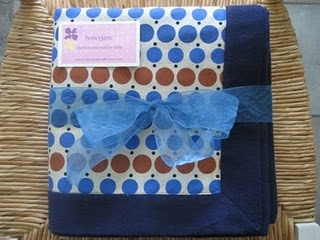






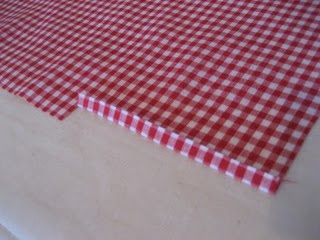


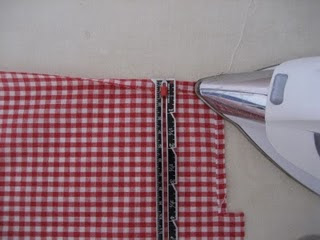



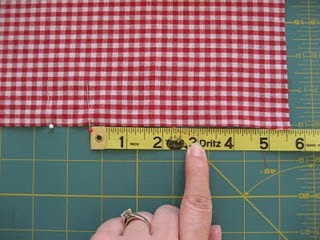



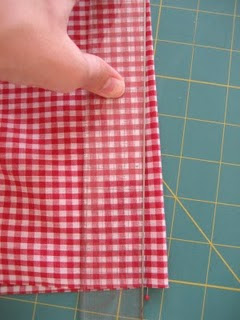
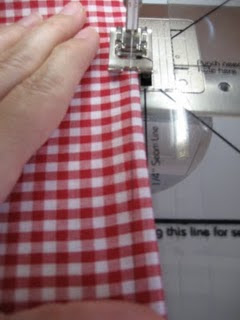
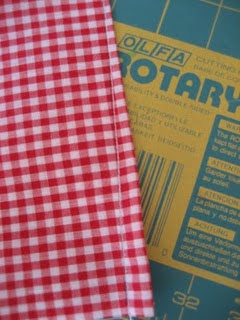

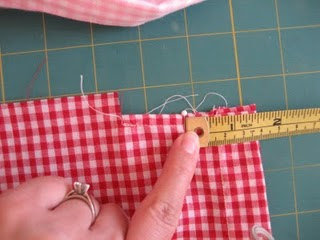






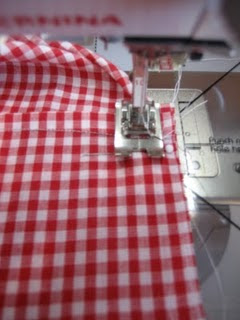

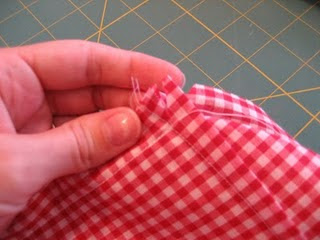
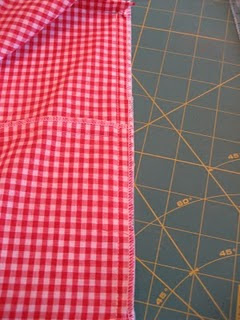

















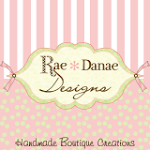








1 comments:
That new ruffled blanket is Melissa's shop is ADORABLE!! Great tutorial-these are so expensive to buy, so it's great to find out how to make my own!! Thanks Liss!
Post a Comment